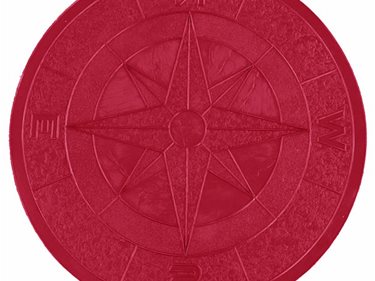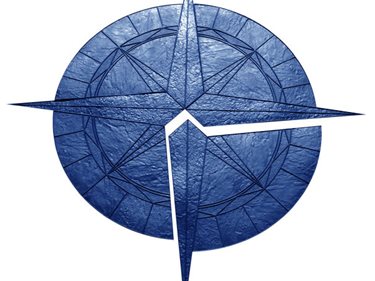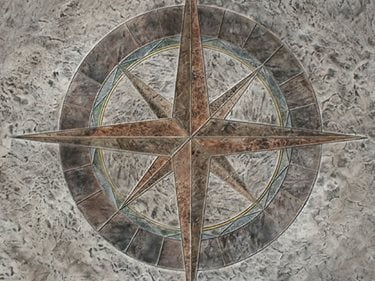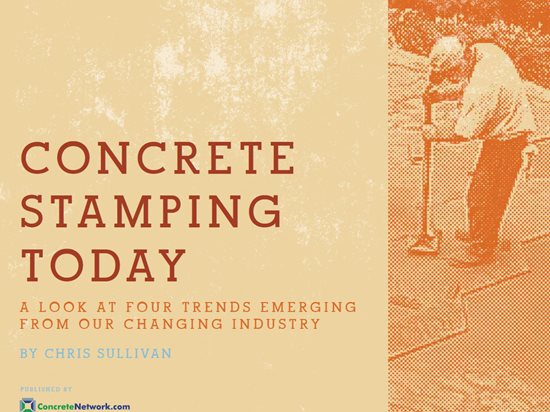- Concrete Stamps
- Get the Look - Stamping Pictures
- Buying Tips for Concrete Stamping Tools: Advice that will help you make smart choices
- Concrete Stamp Cost
- Types of Concrete Stamps: A comparison chart of popular stamps & patterns
- Stamping & Texturing Tools
- Concrete Stamp Mats
- Concrete Texturing Skins
- Medallion Stamps
- Texture Rollers
- Step Forms & Liners
- Installing Stamped Concrete
- How to Stamp Concrete
- Coloring Stamped Concrete
- Concrete Stamp Release Agent
- Sealers for Stamped Concrete
Compass Stamps & Medallions for Concrete
Tips for buying & using medallion stamping tools to customize your next projectTypical applicationsMedallion stamping tools can quickly, and rather easily, transform a typical stamped concrete project from cookie-cutter to custom. The stamps are ideal for contractors who want to customize their work and offer an upsell to set themselves apart from the competition. The first medallion stamps were simple compass rose patterns, but over the last decade many other intricate patterns have been introduced such as Aztec calendars, sunbursts, and floral designs. Medallions are most often used as a centerpiece in stamped concrete patios or commercial pavements, and they work best when incorporated into concrete stamped with a complementary seamless stone pattern.
How to use them Medallion stamps are typically large circular tools, averaging 3 to 5 feet in diameter, and often require two people to set and remove them properly. The tool itself is usually one piece, but larger-diameter tools are often divided into smaller pieces for easier handling. Most medallion stamps are manufactured from semi-rigid polyurethane rubber, which provides the level of detail required as well the flexibility to apply and remove the tool from plastic concrete without causing damage to the surrounding concrete. The tools are designed to be used with standard concrete coloring agents and releases.
Buying tips1. Consider your market.The type of market you serve will often dictate the best medallion patterns to purchase. When Brad Walker, owner of Lonestar Decorative Concrete, Watauga, Texas, looks at making an investment in new medallion stamps, he focuses on the demographics of his area. “I own a medallion stamp with a Texas star pattern, but it makes no sense for someone stamping concrete in New York to own a medallion stamp of a Texas star,” he says. While the Texas star is popular in Texas, a nautical compass medallion stamp does well in coastal areas, and an Aztec calendar stamp is often more appropriate for the Southwest.
2. Go for something unusual.
Brain Farnsworth, director of technical services for Bomanite Group International, recommends looking for medallion stamps with unique patterns. “I want to see new and interesting patterns, as the demand for new designs in concrete is always evolving,” he says.
Free E-book:
Concrete Stamping Today
Discover four emerging trends in concrete stamping from ConcreteNetwork.com’s new e-book. You’ll also get insights and advice from veteran installers that will help you stay profitable in today’s market.
Download Concrete Stamping Today (PDF)
3. Look at tool texture and rigidity.
Farnsworth says that the texture is critical when working with medallion stamps and recommends using tools with a maximum texture depth of ¼ inch. “If you have a tool with deep texture areas, you lose a lot of detail,” he says. Farnsworth also likes tools with “V” or tapered blades so the concrete is spread gently when the tool is placed, compared to flat blades and details that abruptly push the concrete and can cause cracking and loss of detail. When it comes to the tool weight and thickness, Farnsworth prefers a tool that is rigid enough to support his weight so he can get on the concrete earlier. He also says that a rigid tool provides cleaner detail and texture, which is critical when working with medallion stamps.
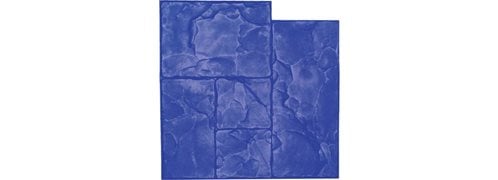 Ashlar Cut Slate Stamp
Hand-tooled with a pronounced texture
Ashlar Cut Slate Stamp
Hand-tooled with a pronounced texture
 Herringbone Used Brick
Tool Size is 44" x 27"
Herringbone Used Brick
Tool Size is 44" x 27"
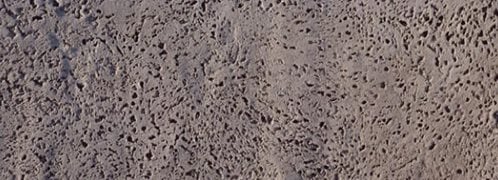 Rock Salt
Seamless travertine off-set
Rock Salt
Seamless travertine off-set
 Bluestone Texturing Skin
6 skin set - only $1,173.20
Bluestone Texturing Skin
6 skin set - only $1,173.20
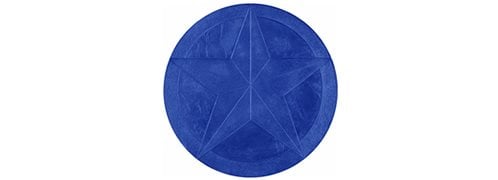 Five Point Star Medallion
Concrete stamp only - $292.00
Five Point Star Medallion
Concrete stamp only - $292.00
 Brickform Stamping Tools
Precision stamping tools
Brickform Stamping Tools
Precision stamping tools
